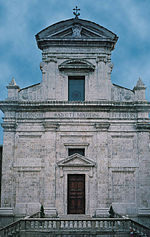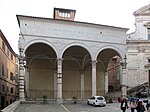Università per Stranieri di Siena
1917 establishments in ItalyBuildings and structures in SienaEducation in SienaEducational institutions established in 1917Europe university stubs ... and 2 more
Italian school stubsUniversities in Tuscany
The Università per Stranieri di Siena is a university in Siena, in Tuscany in central Italy. It is one of the two Italian universities oriented towards study by foreign students (the other is the Università per Stranieri di Perugia in Perugia, in Umbria, established in 1921.
Excerpt from the Wikipedia article Università per Stranieri di Siena (License: CC BY-SA 3.0, Authors).Università per Stranieri di Siena
Via Banchi Di Sotto, Siena Ravacciano
Geographical coordinates (GPS) Address Phone number Website Nearby Places Show on map
Geographical coordinates (GPS)
| Latitude | Longitude |
|---|---|
| N 43.3192 ° | E 11.3325 ° |
Address
Pam Local
Via Banchi Di Sotto 45
53100 Siena, Ravacciano
Tuscany, Italy
Open on Google Maps










